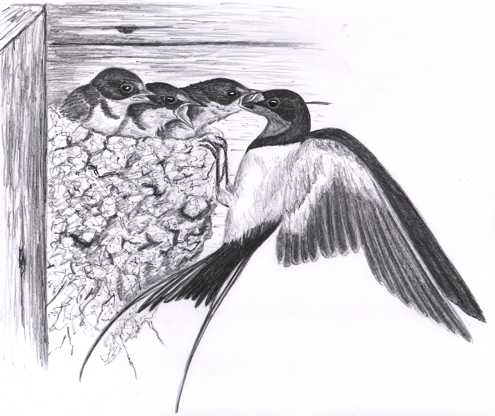
Dear Bird Folks:
When it comes to attracting birds to my yard I have been pretty lucky. I have several hummingbirds at my feeder, turkeys visit almost every day and a pair of bluebirds are nesting in a birdhouse. However, the bird that I would really like to nest in my yard is the Barn Swallow. Do you have any suggestions how I could attract this beautiful bird?
-Adam, Lenox, MA
Hey Adam, get a barn.
Did you really need me to tell you that? The best way to get Barn Swallows to nest in your yard is to get yourself a barn. Like their name says, the Barn Swallow is all about barns. Yes, I know there are a lot of birds whose common names don’t mean much in reality, but the name of this bird is dead on. A barn provides the bird with food, shelter and nesting material. A barn is to a Barn Swallow what the local mall is to a teenager.
Barn Swallows are one of the few species of wildlife that have benefitted from humans. Historically swallows nested in caves or under cliffs. But when people got tired of freezing outside and started building shelters for themselves or their critters to live in, the birds figured they were on to something and quickly moved in too. Now it is rare to find a Barn Swallow’s nest in a natural setting.
Nesting Barn Swallows have three needs, a covered shelter, mud to build their nest with and insects, lots and lots of insects. And if barns have anything going for them it is mud and bugs.
Swallows’ nests are usually found on a rafter or ledge just below the roof. Their nests are securely held to the ledge with pellets of mud that the birds scoop up from the nearest wet area. One of the few times you will ever see Barn Swallows on the ground is when they are filling their faces with mud.
Proper nesting sites are so important to Barn Swallows that if you find one nest you’ll probably find many. Barn Swallows will nest in any dark area protected from the sun and rain. In addition to barns, they will also nest in sheds, beneath overhangs, porches, bridges or under large turtles. Most often found near farms and horse stables eating their share of flies and other annoying insects, swallows can also be found in some unusual places. One unique Cape Cod colony thrived off the coast of Monomoy Island in the wreck of the old tanker Pendleton.
If you don’t have access to a wrecked ocean tanker, Adam, I suggest you go with the old building, or porch overhang approach. If you leave the door or window open in an old shed or garage the birds will be sure to find it. Also, a little shelf tacked up under an eve might be all the birds need to get started. If you happen to be one of those neat freaks who don’t like bird droppings all over your stuff, a small sheet of plastic placed just under the nest should keep your things clean and poop free.
The next step is to get yourself some mud. Swallows’ nests are mostly made of mud. You can easily make your own mud by using the age old recipe of water and organic soil or buy it ready made at your local health food store. Place the tray of mud on the ground where you would like the birds to nest.
Swallows also like to line their nests with feathers. If you don’t have chickens in your neighborhood, the birds would appreciate it if you put your old feathered boa from your dancing days out on the line for them to borrow from.
Like the legendary Cliff Swallows of Capistrano, Barn Swallows tend to return to the same nesting area each spring. If do you succeed in attracting swallows to nest in your yard, Adam, you are probably going to have them for years to come. Barn Swallows will be arriving in Lenox each summer like clock work, just like those weirdos at Tanglewood.